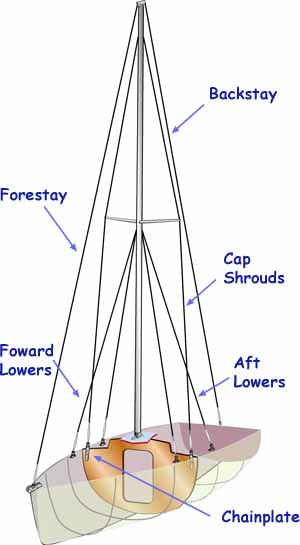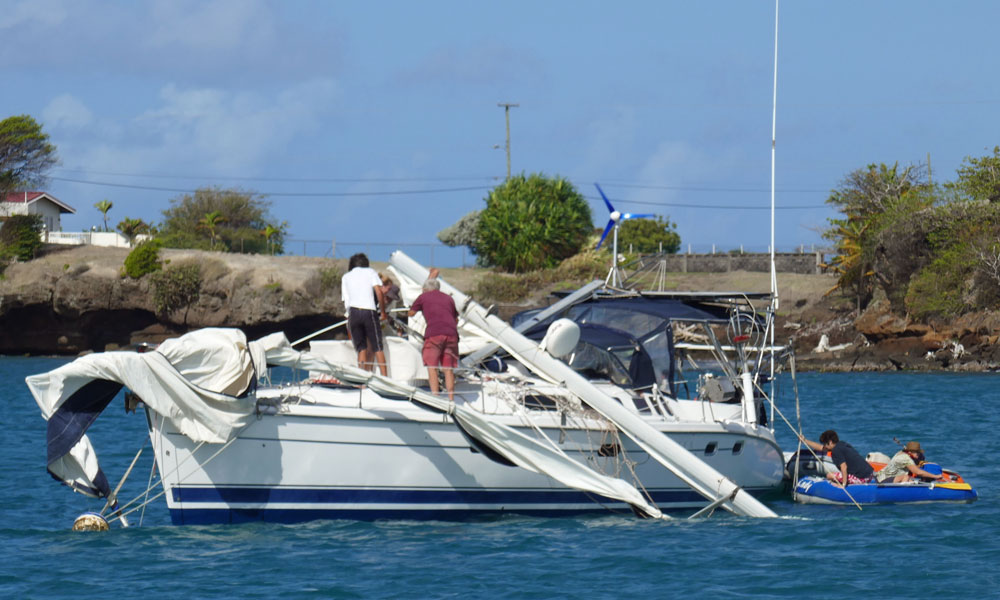Standing Rigging & Mast Tuning: A Guide to a Safer & Faster Sail
In a Nutshell...
Standing rigging is the system of wires and rods that holds your mast upright, while mast tuning is the process of adjusting this rigging to achieve the perfect balance of tension and shape. Proper tuning is crucial for two main reasons: safety and performance. A well-tuned rig ensures the mast is properly supported, preventing catastrophic failure in heavy weather, and it allows the sails to set correctly, which is the key to sailing faster and more efficiently. Regular inspection and adjustment are essential for every sailboat owner, regardless of their experience level.
Table of Contents
As an experienced offshore sailor, I’ve seen firsthand the difference a properly tuned rig can make. From the gentle hum of a perfectly balanced boat on a long passage to the confidence of knowing your mast is secure in a sudden squall, there's nothing quite like it. This article is for every recreational sailor and boat owner who wants to understand the fundamentals of standing rigging & mast tuning and gain the confidence to handle it themselves.
The Purpose of Standing Rigging: A Foundation of Safety & Performance
Standing rigging is, quite simply, the backbone of your sailboat. It consists of the wires, called shrouds and stays, that support the mast. The shrouds run from the mast down to the sides of the boat, while the stays run fore and aft. The entire system is designed to handle immense loads—especially when sailing hard on the wind.
 Standing Rigging
Standing RiggingThink of it like this: your mast is a compression post, and the standing rigging is what keeps it from buckling or collapsing. The tension in the rigging keeps the mast straight and the boat sailing efficiently. A loose rig can cause the mast to pump or bend excessively, leading to fatigue in the metal and, in a worst-case scenario, mast failure. I’ve seen boats lose their masts in conditions that they should have easily handled, all because of a lack of proper tension. It's a sobering reminder of why this isn't just about speed; it's about the safety of you and your crew.
 A dismasting is no fun at all...
A dismasting is no fun at all...How Your Mast & Rigging Work Together
To understand tuning, you first have to see the mast and rigging as a single, dynamic system. The mast isn't just a pole; it's a flexible beam designed to bend in specific ways under load. The standing rigging, with its various stays and shrouds, controls this bend.
- Forestay & Backstay: These are the primary fore and aft supports. The backstay's tension directly controls the bend of the mast. Tightening the backstay pulls the top of the mast aft, which flattens the mainsail and can reduce power—perfect for heavy winds.
- Cap Shrouds: These are the upper side supports, running from the masthead down to the deck. They prevent the mast from falling to the side.
- Lower Shrouds: These run from the mast's base or spreaders to the deck and are crucial for controlling the mast's bend below the spreaders.
- Spreaders: These struts push the shrouds out from the mast, providing a wider base of support and a more effective angle for the stays.
Tuning is the act of balancing the tension of these components to achieve a straight mast in port and the desired sail shape when under sail. The goal is to set the mast straight and then adjust it to induce the right amount of bend to suit the wind conditions.
A Sailor’s Guide to Mast Tuning
Mast tuning can seem intimidating, but it's a manageable task for any sailor. Here's a basic step-by-step guide:
- Start with the Boat Docked: The first step is to get the mast straight and centered. With the boat at the dock, eye the mast from the base and the sides to ensure it’s perfectly plumb. A tape measure can be used to check the distance from the masthead to the deck on both sides.
- Adjust Initial Tension: Begin by tightening the cap shrouds equally on both sides. Use a tension gauge if you have one, or use the "shroud wiggle" method—the shrouds should be too tight to wiggle freely by hand.
- Center the Mast: Once the cap shrouds are snug, check the mast’s alignment again. Adjust the lower shrouds to remove any sideways bend. The goal is to create a straight column.
- Fore & Aft Rake: Next, adjust the forestay and backstay. For most cruisers, a slight aft rake is desirable. This is the amount the mast leans back. You can check this by hanging a weight from the main halyard to see where it lands on the deck.
- Final Checks Under Sail: The true test of your tuning is on the water. Go for a sail in moderate conditions. Observe the mast carefully. Does it bend or pump excessively? Does the mainsail set well? You'll likely need to make small adjustments, tightening or loosening stays as needed to achieve the ideal sail shape and minimal mast movement.
My personal routine after a long passage is always the same: once tied up safely, I'll visually check the entire rig. I’ll run my hands along the wires, check the terminals for any signs of cracking or corrosion, and give everything a solid shake to feel for any looseness. It's a quick, simple habit that has saved me from potential problems more than once.
Signs of a Problem: When to Inspect Your Rigging
Regular inspection is non-negotiable. A good rule of thumb is to inspect your rig at least once a year, or before any major offshore passage. Here’s what to look for:
- Corrosion: Pay close attention to the terminals, swages, and turnbuckles. Look for red-brown rust stains on stainless steel, which can indicate crevice corrosion.
- Broken Wires: Look for any broken strands in the shrouds or stays. Even one broken strand is a sign of a problem that needs immediate attention.
- Cracked Terminals: Inspect the fittings at the end of the wires. Cracks can indicate fatigue and are a precursor to failure.
- Worn Sheaves & Pins: Check the sheaves at the masthead and the pins that connect the rigging to the chainplates on deck. Excessive wear can lead to failure.
This guide is a helpful tool for sailors, but for a comprehensive overview of all aspects of sailboat rigging, you can return to our A-Z of Sailboat Rigging & Maintenance Guide.
This article was written by Dick McClary, RYA Yachtmaster and author of the RYA publications 'Offshore Sailing' and 'Fishing Afloat', member of The Yachting Journalists Association (YJA), and erstwhile member of the Ocean Cruising Club (OCC).
Frequently Asked Questions About Rigging & Mast Tuning
What is the difference between standing & running rigging?
What is the difference between standing & running rigging?
Standing rigging is the fixed, non-moving part that holds the mast up (e.g., shrouds & stays). Running rigging is the part that moves to control the sails (e.g., halyards & sheets).
How often should I replace my standing rigging?
How often should I replace my standing rigging?
As a general rule, many manufacturers and marine surveyors recommend replacing standing rigging every 10-15 years, depending on the boat's use and the conditions it sails in.
Do I need a professional rigger to tune my mast?
Do I need a professional rigger to tune my mast?
While a professional rigger is highly recommended for complex or first-time tuning, a basic tune is within the capabilities of most competent sailors. Regular inspection is a job for every owner.
What is a rig check, and how do I do one?
What is a rig check, and how do I do one?
A rig check is a visual inspection of all the components of your standing rigging. You should look for corrosion, cracks, loose fittings, and broken strands. This is a crucial safety task.
Sources Used
Brion Toss's The Complete Rigger's Apprentice: http://www.briontoss.com/catalog/info_riggers_apprentice.htmlPractical Sailor Magazine: https://www.practical-sailor.com/ US Sailing's articles on rigging: https://www.ussailing.org/wp-content/uploads/2022/03/first367_quantum_tuning_guide.pdf
Recent Articles
-
Hans Christian 43: Classic Bluewater Cruiser & Liveaboard Sailboat
Dec 10, 25 04:37 AM
Explore the Hans Christian 43: a legendary heavy-displacement, long-keel sailboat. Read our in-depth review of its specs, design ratios, and suitability for offshore cruising and living aboard. -
Planning Your Sailboat Liveaboard Lifestyle: An Ocean Sailor's Guide
Dec 06, 25 05:18 AM
Seasoned sailors share their methodical risk analysis for planning a secure Sailboat Liveaboard Lifestyle, covering financial, property, and relationship risks. -
Marine Cabin Heaters: The Expert’s Guide to Comfort & Safety at Sea
Dec 05, 25 06:52 AM
Choose the best Marine Cabin Heaters for your vessel. Expert advice on diesel, paraffin, and hot water systems for year-round cruising comfort.












